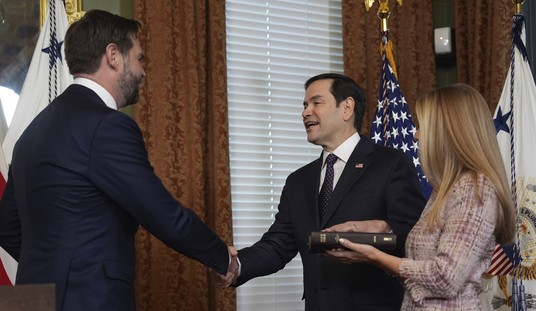The #RESIST! Trump movement generates all sorts of opposition to various initiatives proposed by the President, many of which I can understand, even if I don’t agree with them. Some people don’t like his emphasis on reducing illegal immigration because they don’t think it’s a problem. Others don’t want to see him reduce the size of government because they think Big Government does super things. More than a few oppose his proposed tax cuts because… well, I guess they don’t like having too much money. But one of the President’s early plans called for reducing crime and making people safer by supporting and expanding law enforcement. “The Trump Administration will be a law and order administration for a country that needs more law enforcement.”
Do you think there are people opposed to that idea, aside from possible worries over the costs involved? Well, amazingly enough there are. One of them is Danielle Allen, a Harvard professor and “political theorist.” In an opinion piece published at the Washington Post, Professor Allen proclaims that a desire for “more law enforcement” is not only debatable, but… surreal.
She begins by pointing out that nearly 1 in every 100 Americans is incarcerated, creating a penal system the likes of which the world has never seen. She then offers this early conclusion as to the nature of the problem we should actually be wrestling to the ground. (Emphasis added.)
More than half of our prison population is black or Hispanic, but these are not the groups that saw the largest increase in imprisonment from 2002 to 2010. That prize goes to white women. The volume of our law enforcement has achieved world-historical magnitude. The idea that we need more law enforcement sends chills down my spine.
The fact of our historic levels of incarceration should provoke us to consider whether perhaps we need not increases in law enforcement but different approaches to criminal justice.
The professor is driving toward a deeper point which I’ll get to in a moment, but we need to stop right here first. Stop and consider the argument being made. We have an historic number of people in jail. Therefore, this argument concludes, we should have less law enforcement so there won’t be so many people in jail. With all due respect to Professor Allen (and I’m not trying to blow anyone’s mind here), that’s like observing the large number of flood control levees along the Mississippi and many other rivers in America and concluding that if we just tore down a bunch of those barriers the rivers might get the idea and stop flooding so much.
This way lies insanity.
Continuing on, Allen eventually gets to the actual solution she’s shooting for, which is the long popular subject of drug legalization. If we stop locking up so many drug offenders, she argues, a host of other problems might be addressed at the same time. To bolster her argument she summons up some figures which you see almost weekly on MSNBC but which are highly suspect if not already disproven.
Fourteen percent of imprisoned Americans have been sentenced for nonviolent drug offenses. And then there are all the violent offenses that flow from the intertwining double helix of drugs and gangs. But that is not all.
In recent years, as many as 32 percent of defendant filings in federal courts, in a given year, are for drug-related cases. This is the biggest category of filings. They are a large category in states, too. In other words, the illegal drug economy overburdens our judicial system and increases prosecutorial workloads. There is good reason to think that this overload helps explain why homicide clearance rates have fallen as low as they have, leading to a phase shift in levels of violence in urban areas.
That 32% number gets tossed around all the time but it’s a complete red herring. In a bit of irony, the Washington Post’s own “related materials” search on the page with Allen’s op-ed leads you almost immediately to a column published back in 2015 by Charles Lane titled, “Ending the war on drugs would not end mass incarceration.” In it, Lane addresses these false statistics cited so often today that they’ve become accepted as fact.
In 2014, 46 percent of all state and federal inmates were in for violent offenses (murder, rape, robbery and aggravated assault), according to the latest Justice Department data. And this is a conservative estimate, since the definition of violent offense excludes roughly 30,000 federal prisoners, about 16 percent of the total, who are doing time for weapons violations.
Drug offenders account for only 19.5 percent of the total state-federal prison population, most of whom, especially in the federal system, were convicted of dealing drugs such as cocaine, heroin and meth, not “smoking marijuana.”
If you’re talking about legalizing marijuana for private consumption, I say let’s have that debate. There’s plenty of merit to the argument, though I know many conservatives still disagree and make forceful cases on the opposing side. But let’s not pretend that “stopping locking people up for smoking pot” is going to make a difference in prison numbers. Most of those “drug-related cases” which Allen lists in her alarming 32% figure are cases where drug activity may have been one element of the conviction, but they frequently also include violence and weapons violations. And the ones which are strictly drug related are almost exclusively there for heroin, coke and meth labs.
As Lane points out, there is virtually nobody behind bars anywhere for any significant amount of time just for personal possession or use of pot. The exceptions might be those swept up in variations of the Three Strikes laws. I agree those need a fresh look, but releasing all of them today wouldn’t change our incarceration numbers measurably. If the argument is that we should be legalizing or even decriminalizing all drugs, that’s just insane.
But in conclusion, I just wanted to point out this op-ed and the curious way that liberals can arrive at almost any conclusion if the destination is desirable enough. That includes arguing that we should actually have “less law enforcement.” Tell that to the people in Chicago and Baltimore, who are in the midst of a murder epidemic. And they are far from the only examples. You don’t make crime decrease by reducing the number of people looking for it and combating it. That’s simply putting your head in the sand.








Join the conversation as a VIP Member